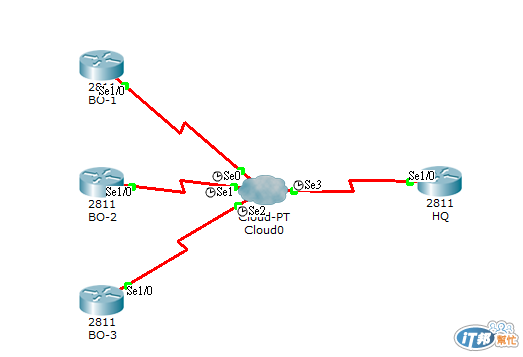借用: Router 上 該介面並沒有ip 卻想要使用,所以跟別的介面借ip,來使該介面可以正常使用
意義: 減少ip消耗
=======
一般使用環境類似於:

總公司HQ 要跟分公司( BO-1 、 BO-2 、 BO-3) 溝通
可跟不同介面溝通就要用不同ip
而最小網段也要消耗4個位址
可是保留下來的位址也僅僅只是用於溝通而已
所以 ip unnumber 因此而生
============
使用規則:
1.如果被借用方有多個ip位址,則只能借用主ip
2.被借方 其本身不可是 借用方 (即被借方的ip 須是以 ip address 得到而非使用 ip unnumbered 得到)
3.被借方的位址可以給多個介面借用
4.借用方不可以是 乙太網接口
5.point-to-point 會自動跟對方協商路由,而非point-to-point 則需手動設定靜態路由或使用動態路由
6.當介面是經由 ip unnumber 取得 ip 時 , 動態路由並不會去檢查 對方的 source ip ==> 雙方不同網段 也可建起鄰居
7.如果 被借方並無設定 ip位址 , 則借用方將取得 0.0.0.0
==========================================
前言: 這次使用 GNS3 做為模擬環境測試

R1 和 R2 的 Serial 1/0 皆向 Loopback 0 借用 ip , Loopback 1 則模擬各自內網
實驗: 讓彼此內網可以互通
## 以下所有實驗皆只示範 R1 的指令 , R2 跟 R1 相同 故不再重複贊述
基礎環境:
R1(config)#interface loopback 0
R1(config-if)#ip add 1.1.1.1 255.255.255.255
R1(config-if)#interface loopback 1
R1(config-if)#ip add 192.168.1.254 255.255.255.0
R1(config-if)#interface serial 1/0
R1(config-if)#ip unnumbered loopback 0 ## 向 looback 0 借 ip
## 看
R1#show ip interface brief
Interface IP-Address OK? Method Status Protocol
FastEthernet0/0 unassigned YES unset administratively down down
FastEthernet0/1 unassigned YES unset administratively down down
Serial1/0 1.1.1.1 YES TFTP up up
Serial1/1 unassigned YES unset administratively down down
Serial1/2 unassigned YES unset administratively down down
Serial1/3 unassigned YES unset administratively down down
Loopback0 1.1.1.1 YES manual up up
Loopback1 192.168.1.254 YES manual up up
Tunnel0 unassigned YES unset up down
===============================================
R1(config)#ip route 2.2.2.2 255.255.255.255 serial 1/0 ## 要到對方 2.2.2.2 需由 serial 1/0 出去
R1(config)#ip route 192.168.2.0 255.255.255.0 2.2.2.2 ## 到對方內網 交給 2.2.2.2
## 測試雙方 內網互ping
R1#ping 192.168.2.254 source 192.168.1.254
Type escape sequence to abort.
Sending 5, 100-byte ICMP Echos to 192.168.2.254, timeout is 2 seconds:
Packet sent with a source address of 192.168.1.254
!!!!!
Success rate is 100 percent (5/5), round-trip min/avg/max = 16/23/32 ms
R1(config)#router rip
R1(config-router)#version 2
R1(config-router)#no auto-summary
R1(config-router)#network 192.168.1.0
R1(config-router)#network 1.0.0.0
## 看
R1#sh ip route
Codes: C - connected, S - static, R - RIP, M - mobile, B - BGP
D - EIGRP, EX - EIGRP external, O - OSPF, IA - OSPF inter area
N1 - OSPF NSSA external type 1, N2 - OSPF NSSA external type 2
E1 - OSPF external type 1, E2 - OSPF external type 2
i - IS-IS, su - IS-IS summary, L1 - IS-IS level-1, L2 - IS-IS level-2
ia - IS-IS inter area, * - candidate default, U - per-user static route
o - ODR, P - periodic downloaded static route
Gateway of last resort is not set
1.0.0.0/32 is subnetted, 1 subnets
C 1.1.1.1 is directly connected, Loopback0
2.0.0.0/32 is subnetted, 1 subnets
R 2.2.2.2 [120/1] via 2.2.2.2, 00:00:02, Serial1/0
C 192.168.1.0/24 is directly connected, Loopback1
R 192.168.2.0/24 [120/1] via 2.2.2.2, 00:00:02, Serial1/0
##當介面使用 ip unnumbered 時,動態路由協定並不會去檢查對方 source ip
R1(config)#ip route 192.168.2.0 255.255.255.0 2.2.2.2 ## 到對方內網 交給 2.2.2.2
## 當使用 point-to-point 時 雙方會自動協商,所以一開始就可以互ping (R1 ping 2.2.2.2 應該要成功)
同上,不再贊述
